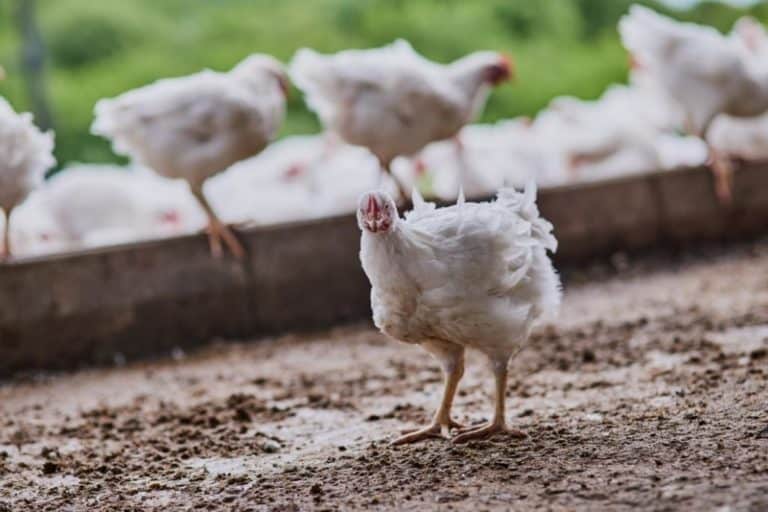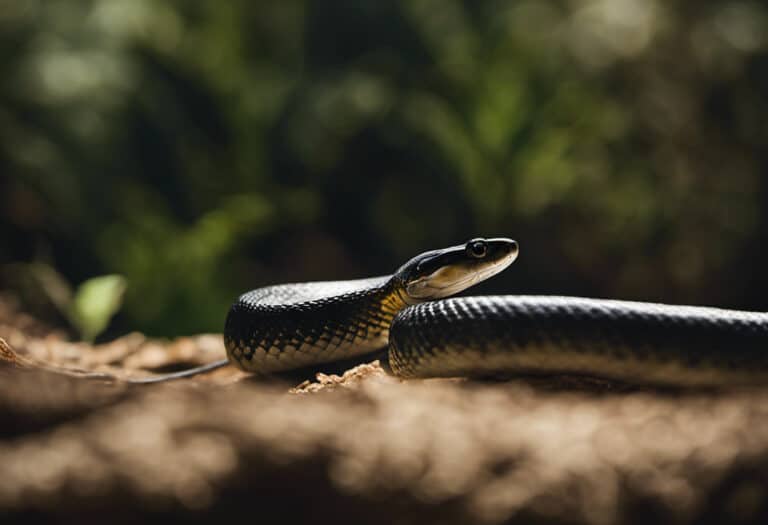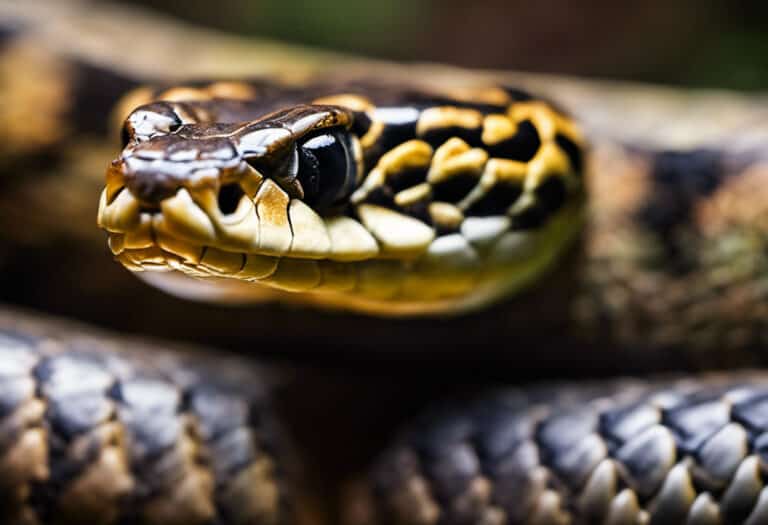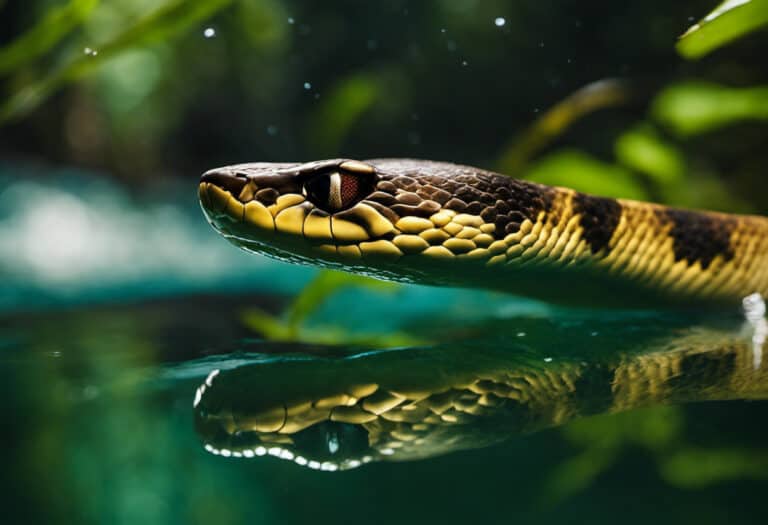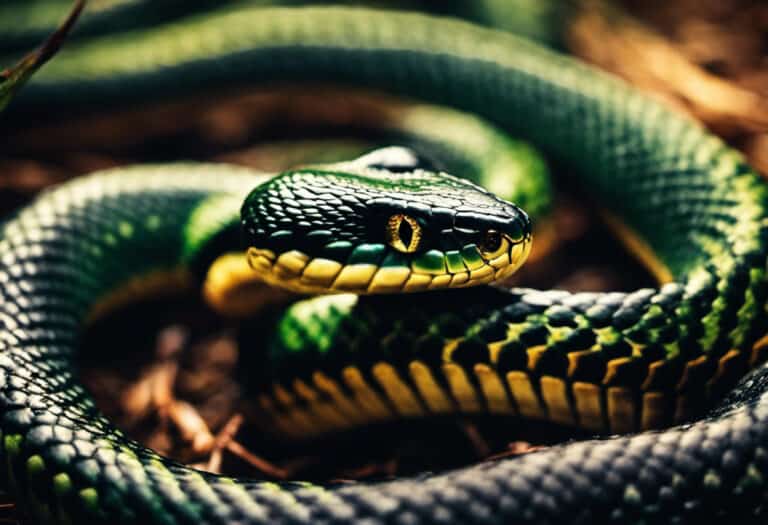What Do Scarlet Snakes Eat?
Ever wondered what you’re missing out on when it comes to scarlet snakes’ diet?
Delve into the intriguing world of these fascinating reptiles as we explore their feeding habits.
Scarlet snakes, measuring 14-20 inches long, are found in the coastal regions of the southeastern United States. They primarily feed on eggs of other snakes and lizards, using their enlarged teeth to crack open larger eggs.
These nocturnal creatures also consume small frogs, snakes, and lizards, playing a vital role in controlling reptile populations.
Discover the wonders of scarlet snakes’ diet with us.
Key Takeaways
- Scarlet snakes primarily feed on the eggs of other snakes and lizards.
- They also consume small frogs, snakes, and lizards.
- Scarlet snakes have enlarged teeth to open eggs that are too large for them to swallow whole.
- Their feeding habits contribute to controlling populations of other reptiles.
Prey of Scarlet Snakes
Scarlet snakes primarily feed on the eggs of other snakes and lizards, using their enlarged teeth to open them.
This snake species has a particular preference for consuming snake eggs, as well as the eggs of lizards. Additionally, scarlet snakes may also consume small frogs, snakes, and lizards.
They’re nocturnal creatures, which means they’re most active during the night when they search for their prey.
By feeding on the eggs of other reptiles, scarlet snakes play an important role in controlling the populations of these species. Their diet contributes to maintaining the ecological balance within their habitats.
It’s worth noting that scarlet snakes are non-venomous, making them harmless to humans and providing a sense of freedom when encountering them in the wild.
Diet of Scarlet Snakes
Scarlet snakes have a varied diet that primarily consists of the eggs of other snakes and lizards, contributing to the control of reptile populations. Their specialized teeth allow them to open eggs that are too large to swallow whole.
Additionally, they occasionally consume small frogs, snakes, and lizards.
Snake Egg Consumption
When it comes to their diet, you’ll be interested to know that scarlet snakes primarily feed on the eggs of other snakes and lizards. These non-venomous snakes have adapted to consume snake eggs as a significant part of their diet. With their specialized teeth, scarlet snakes can open eggs that are too large for them to swallow whole.
This unique feeding behavior has important implications for reptile populations. By consuming the eggs of other snakes and lizards, scarlet snakes help regulate their numbers and prevent overpopulation. This predation on eggs plays a vital role in maintaining the balance of reptile populations in their habitats.
While scarlet snakes also consume small frogs, snakes, and lizards, their preference for snake eggs demonstrates their ecological impact on reptile communities.
Impact on Reptile Populations
By consuming the eggs of other snakes and lizards, scarlet snakes help regulate their numbers and maintain the balance of reptile populations in their habitats. This ecological role has a significant impact on the reptile populations in their environment.
Here are five ways scarlet snakes contribute to the ecosystem:
- By feeding on the eggs of other snakes and lizards, scarlet snakes help control their population growth.
- By reducing the number of eggs, scarlet snakes prevent overcrowding and competition for resources among reptiles.
- Scarlet snakes play a crucial role in maintaining the diversity of reptile species in their habitats.
- Their feeding habits contribute to the overall health of reptile populations by preventing overpopulation of certain species.
- By maintaining a balance in reptile populations, scarlet snakes ensure the stability and resilience of the ecosystem.
Nocturnal Feeding Behavior
You can observe the nocturnal feeding behavior of scarlet snakes as they primarily consume the eggs of other snakes and lizards. These snakes have developed unique hunting techniques and foraging strategies to locate and consume their prey.
They use their keen sense of smell to detect the scent of reptile eggs, which they then track down and devour. Scarlet snakes have specialized teeth that allow them to open and consume eggs that are too large to swallow whole. They also consume small frogs, snakes, and lizards.
These feeding habits contribute to controlling populations of other reptiles in their habitat. This nocturnal behavior ensures that scarlet snakes can hunt and feed without interference from diurnal predators.
Through these hunting techniques and foraging strategies, scarlet snakes have adapted to efficiently obtain their primary food source and thrive in their environment.
Food Sources for Scarlet Snakes
Scarlet snakes primarily feed on the eggs of other snakes and lizards, contributing to controlling populations of other reptiles. Their prey selection and hunting strategies are fascinating.
Here are five key points to help you understand their food sources:
- Scarlet snakes have enlarged teeth specifically designed to open eggs that are too large for them to swallow whole.
- They also consume small frogs, snakes, and lizards, expanding their diet and ensuring a diverse range of prey.
- These snakes are nocturnal hunters, relying on their excellent night vision to locate their food sources.
- Scarlet snakes use their keen sense of smell to detect the scent of eggs and prey, allowing them to pinpoint their targets accurately.
- Their feeding habits play a crucial role in regulating the populations of other reptiles, ensuring a healthy balance in the ecosystem.
What Do Scarlet Snakes Feed On
Scarlet snakes primarily feed on the eggs of other snakes and lizards, using their enlarged teeth to open eggs that are too large to swallow whole. They also consume small frogs, snakes, and lizards.
As nocturnal hunters, scarlet snakes play an important ecological role in controlling populations of other reptiles.
Prey Preferences of Scarlet Snakes
One interesting aspect of scarlet snakes is their feeding habits, as they primarily consume the eggs of other snakes and lizards. This prey selection is an essential part of their foraging behavior. To give you a vivid picture of their feeding habits, imagine the following:
- Scarlet snakes slithering through the forest, their vibrant red, yellow, and black bands blending in with the surroundings.
- Using their enlarged teeth, they skillfully open the eggs that are too large for them to swallow whole.
- Under the cover of darkness, these nocturnal hunters actively search for nests and devour the precious eggs.
- Occasionally, they also indulge in small frogs, snakes, and lizards, expanding their diet.
- Through their feeding habits, scarlet snakes play a crucial role in controlling the populations of other reptiles, ensuring the balance of the ecosystem.
Understanding the scarlet snake’s prey selection and foraging behavior provides valuable insight into their contribution to the natural environment.
Ecological Role of Scarlet Snakes
As you explore the ecological role of scarlet snakes, you’ll discover their important contribution to controlling the populations of other reptiles. Scarlet snakes play a crucial role in the ecosystem by primarily feeding on the eggs of other snakes and lizards, thus impacting prey populations.
With their specialized teeth, they can open and consume eggs that are too large for them to swallow whole. This feeding habit helps to regulate the populations of other reptiles, ensuring a balance in the ecosystem.
Moreover, scarlet snakes are nocturnal, which allows them to actively hunt and control prey populations during the night. Their ability to control the populations of other reptiles highlights their significance in maintaining the overall health and stability of the ecosystem.
Feeding Behavior of Scarlet Snakes
When searching for food, you’ll find that scarlet snakes primarily feed on the eggs of other snakes and lizards. Their prey selection and foraging behavior are fascinating to observe. Here are some details to help you understand their feeding habits:
- Scarlet snakes have specialized teeth that allow them to open eggs that are too large for them to swallow whole.
- They also consume small frogs, snakes, and lizards, contributing to the control of other reptile populations.
- Being nocturnal creatures, scarlet snakes are most active at night when they hunt for their prey.
- Their diet of eggs provides them with essential nutrients and energy.
- By consuming the eggs of other snakes and lizards, scarlet snakes play a vital role in regulating the population of these species.
Observing scarlet snakes in their natural habitat, engaging in their prey selection and foraging behavior, is a testament to the freedom and diversity of nature’s intricate web of life.
The Eating Habits of Scarlet Snakes
To understand the eating habits of scarlet snakes, you’ll find that they primarily consume the eggs of other snakes and lizards. This prey selection is an important feeding adaptation for these non-venomous snakes.
Scarlet snakes have enlarged teeth that allow them to open the eggs, which are often too large for them to swallow whole. They also consume small frogs, snakes, and lizards, further contributing to controlling populations of other reptiles.
These feeding habits make scarlet snakes an important part of the ecosystem, as they help to maintain a balance among reptile populations.
Being nocturnal, scarlet snakes mostly feed at night, using their specialized feeding adaptations to locate and consume their prey. By understanding their feeding habits and adaptations, we can appreciate the unique role that scarlet snakes play in their environment.
| Prey Selection | Feeding Adaptations |
|---|---|
| Eggs of snakes and lizards | Enlarged teeth to open eggs |
| Small frogs, snakes, and lizards | Nocturnal feeding behavior |
Frequently Asked Questions
How Do Scarlet Snakes Locate and Capture Their Prey?
Scarlet snakes locate their prey by relying on their keen sense of smell and their ability to detect vibrations in the ground. Once located, they use their quick strikes and strong constriction to capture and subdue their prey.
Do Scarlet Snakes Have Any Predators That Feed on Them?
Scarlet snakes, with their vivid colors, are a sight to behold. But they are not invincible. In the wild, they have predators that prey on them, and they rely on their hunting techniques to stay safe.
Are There Any Specific Adaptations That Scarlet Snakes Have for Consuming Eggs?
Scarlet snakes have specific adaptations for consuming eggs. Their enlarged teeth allow them to open eggs that are too large to swallow whole. This snake digestion strategy is important for their feeding habits and controlling reptile populations.
What Is the Nutritional Value of the Eggs That Scarlet Snakes Consume?
The nutritional content and dietary benefits of the eggs consumed by scarlet snakes are still being studied. These eggs provide essential nutrients for the snakes’ growth and survival, contributing to their overall health and reproductive success.
Are Scarlet Snakes Capable of Consuming Prey Items Larger Than Themselves?
Scarlet snakes are capable of consuming prey items larger than themselves. They have enlarged teeth to open eggs and can also eat small frogs, snakes, and lizards. Their feeding behavior and adaptations contribute to controlling populations of other reptiles.
Conclusion
In conclusion, the scarlet snake’s diet consists mainly of the eggs of other snakes and lizards, as well as small frogs, snakes, and lizards. Their enlarged teeth enable them to open larger eggs that they can’t swallow whole.
As nocturnal creatures, scarlet snakes play a crucial role in controlling other reptile populations, contributing to the balance of the ecosystem.
However, due to their resemblance to venomous coral snakes, it’s important to correctly identify these species for safety.
Explore the fascinating world of scarlet snakes and their intriguing feeding habits.
